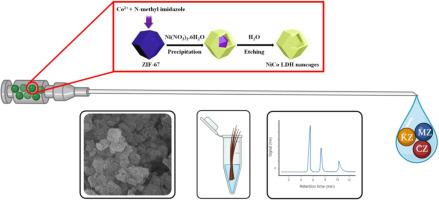Multiple-shell amorphous Co/Ni-(PO4)x(OH)y hollow layered double hydroxide for enhanced extraction of some azole antifungals from biological samples
IF 6.5
Q1 CHEMISTRY, ANALYTICAL
引用次数: 0
Abstract
Antifungals drugs are widely used for variety of fungal infections. Extraction and determination of these drugs in biological sample is crucial because of their toxicity, endocrine-disrupting, and cytochrome P450-mediated effects. In addition, developing an efficient and stable sorbent with a high surface area for microextraction by packed sorbent (MEPS) technique is of great interest. Triple-shell Co/Ni-based hydroxide phosphate (TS-CNHP) was synthesized for increasing surface area. For characterization of TS-CNHP, a combination of advanced analytical methods was employed. Field-emission scanning electron microscopy, transmission electron microscopy, Fourier-transform infrared spectroscopy, Brunauer–Emmett–Teller, dynamic light scattering and X-ray diffraction. In this work the MEPS was coupled with high-performance liquid chromatography equipped with an ultraviolet detector (HPLC-UV). The TS-CNHP demonstrated an impressive level of efficiency and the selectivity for the adsorption of azole antifungals. The optimal conditions for MEPS were determined through a systematic evaluation of key parameters influencing analyte extraction efficiency. These parameters included: pH (6), adsorption time (7 min), adsorption cycles (2 cycles), salt addition (0%), elution solvent (methanol), desorption flow rate (100 µL min-1), desorption volume (400 µL), and desorption cycles (2 cycles). The analytical performance of the method was thoroughly assessed under optimized conditions. The relative standard deviations (RSDs) ranged from 2.7% to 5.4%, demonstrating a high level of precision. Furthermore, extraction recoveries were observed between 78.0% and 89.7%. A wide linear dynamic range (0.5–1000 μg l-1) and an acceptable LOD (0.2 µg L−1) for all of the analytes were achieved. The coefficients of determination (R2) of ketoconazole, clotrimazole and miconazole are 0.9985, 0.9986 and 0.9989 respectively, which demonstrating the reliability of the method The proposed MEPS-HPLC-UV technique demonstrates remarkable analytical efficiency in the extraction and quantification of trace levels of azole antifungals from biological matrices, specifically dog and human hair.

多壳无定形Co/Ni-(PO4)x(OH)y空心层状双氢氧化物增强生物样品中某些唑类抗真菌物质的提取
抗真菌药物广泛用于各种真菌感染。由于这些药物的毒性、内分泌干扰和细胞色素p450介导的作用,在生物样品中提取和测定这些药物至关重要。此外,利用填充吸附剂(MEPS)技术开发一种高效、稳定、高表面积的微萃取吸附剂也具有重要意义。合成了三壳层Co/ ni基氢氧化磷(TS-CNHP),以增加比表面积。为了表征TS-CNHP,结合了先进的分析方法。场发射扫描电子显微镜,透射电子显微镜,傅里叶变换红外光谱,布鲁诺尔-埃米特-泰勒,动态光散射和x射线衍射。在这项工作中,MEPS与配备紫外检测器的高效液相色谱(HPLC-UV)相结合。TS-CNHP表现出了令人印象深刻的效率和选择性吸附唑类抗真菌物质。通过对影响分析物萃取效率的关键参数进行系统评价,确定了MEPS萃取的最佳工艺条件。这些参数包括:pH(6)、吸附时间(7 min)、吸附次数(2次)、加盐量(0%)、洗脱溶剂(甲醇)、解吸流量(100µL min-1)、解吸体积(400µL)、解吸次数(2次)。在优化条件下,对该方法的分析性能进行了全面评价。相对标准偏差(rsd)范围为2.7% ~ 5.4%,具有较高的精度。提取回收率在78.0% ~ 89.7%之间。所有分析物具有宽的线性动态范围(0.5-1000 μg L -1)和可接受的LOD (0.2 μg L -1)。酮康唑、克霉唑和咪康唑的测定系数(R2)分别为0.9985、0.9986和0.9989,证明了该方法的可靠性。MEPS-HPLC-UV技术在提取和定量生物基质(特别是犬和人毛发)中痕量唑类抗真菌药物方面具有良好的分析效率。
本文章由计算机程序翻译,如有差异,请以英文原文为准。
求助全文
约1分钟内获得全文
求助全文

 求助内容:
求助内容: 应助结果提醒方式:
应助结果提醒方式:


